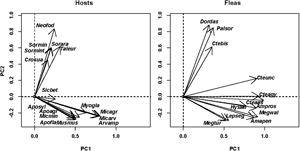Published online by Cambridge University Press: 20 September 2021

We investigated the patterns of phylogenetic and functional (dis)similarity in the species composition of host spectra between co-habitating generalist flea species in regional assemblages from four continents (Europe, Asia, North America and Africa) using a recently developed ordination approach (Double Similarity Principal Component Analysis). From the functional perspective, we considered physiological [body mass and basal metabolic rate (BMR)] and ecological (shelter depth and complexity) host traits. We asked (a) whether host phylogeny, physiology or ecology is the main driver of (dis)similarities between flea host spectra and (b) whether the patterns of phylogenetic and functional (dis)similarity in host spectra vary between flea assemblages from different continents. Phylogenetic similarity between the host spectra was highest in Africa, lowest in North America and moderate in Europe and Asia. In each assemblage, phylogenetic clusters of hosts dominating in the host spectra could be distinguished. The functional similarity between the host spectra of co-occurring fleas was low for shelter structure in all assemblages and much higher for body mass and BMR in three of the four assemblages (except North America). We conclude that host phylogeny and shelter structure are the main drivers of (dis)similarity between the host spectra of co-habitating fleas. However, the effects of these factors on the patterns of (dis)similarity varied across continents.
Present affiliation and address: Clinvet International, Uitzich Road, Bainsvlei, 9338 Bloemfontein, Free State, South Africa.